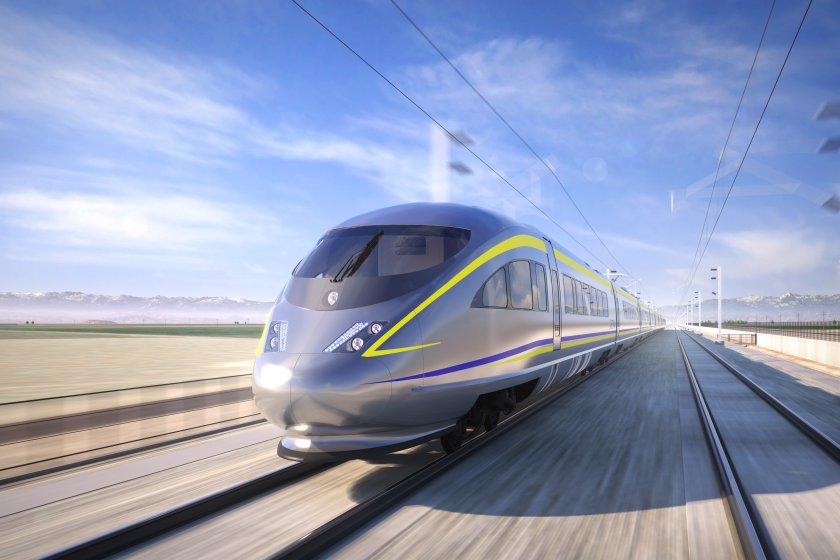Southland Debates the Merits of Magnetic Levitation
- Share via
The vision is too tempting for many transportation planners to resist: sleek, high-tech trains slipping silently across the landscape at 200 mph.
Governments in Maryland, Pennsylvania and elsewhere have debated for years whether trains that use “magnetic levitation” are the answer to their transportation problems.
For the record:
12:00 a.m. April 3, 2004 For The Record
Los Angeles Times Saturday April 03, 2004 Home Edition Main News Part A Page 2 National Desk 1 inches; 54 words Type of Material: Correction
Magnetic levitation -- An article in Tuesday’s California section about trains that use magnetic levitation incorrectly reported that the Chinese government discontinued service on its maglev high-speed rail line from Shanghai to Pudong International Airport. The service is still running. Chinese officials have abandoned plans to build a maglev line between Shanghai and Beijing.
In California, the technology has been considered for various high-speed rail projects -- most recently a proposed line that would whisk travelers from Los Angeles to Ontario International Airport.
Gliding inches above their tracks, so-called maglev trains move quickly and quietly. Many transit planners say the trains would be attractive enough to draw Southern Californians out of their cars at a time when traffic congestion threatens to overwhelm the region.
But skeptics wonder why the idea keeps coming up. Like supersonic passenger airline service, it’s a form of transit that has been technologically feasible for decades but has yet to become economically viable.
Maglev rail lines could cost $80 million a mile to build and have yet to be tested on a large scale.
Tom Rubin, a transportation consultant and former chief financial officer for the Southern California Rapid Transit District, compares maglev rail to the recently abandoned Concorde supersonic jetliner, which “just did not make commercial sense -- and there were too many other problems with it.”
“That’s an unbelievable quantity of money that would never be justified,” said another skeptic, Michael McNally, a civil engineering professor at UC Irvine.
Zahi Faranesh, who studies transportation as the maglev program manager for the Southern California Assn. of Governments, disagrees, arguing that the speed and comfort of magnetic levitation would lure passengers who might not consider conventional trains.
“You have to look to the future,” Faranesh said. “This is what you’re going to see in all the big urban areas.”
Maglev trains run on tracks, called guideways, lined with metal coils. The coils create a magnetic field that pulls the train along at speeds as high as 300 mph. If the trains were ever brought to Southern California, they would probably run between 100 and 200 mph.
The magnetic field causes the train to levitate above the track anywhere between half an inch and nearly four inches, depending on the type of guideway. The train moves almost silently because there is little friction and no conventional engine aboard.
The maglev train was developed in the 1960s by Transrapid International, a joint venture of three German companies. Several test tracks and trains, some that carried passengers, were built in the 1970s.
By 1990, more than 220,000 visitors had paid to ride the trains. But ridership wasn’t high enough to persuade German companies to develop the technology for commercial use.
Japan built a test track in the 1960s, and engineers there continue to improve on the technology. With passengers on board, a Japanese maglev train reached 360 mph in December.
The first attempt at commercial use of maglev technology was an 18-mile test track a German company, under Chinese government contract, built from Shanghai to Pudong International Airport, beginning in 2001.
After three years of construction and testing, commercial passenger service began at the beginning of this year, but ended just two weeks later.
Chinese officials, citing low ridership, the high cost of expansion and problems integrating the system with conventional rail, decided to abandon the project.
In the United States, maglev trains have been proposed in Maryland since the early 1990s as part of a plan to serve commuters between Baltimore and Washington, D.C.
Pittsburgh is also considering a maglev rail line to run throughout the city. Future extensions would go to Harrisburg and Philadelphia.
Maglev trains have been considered several times in California -- for high-speed lines running from Southern to Northern California, from Orange County to Las Vegas and, most recently, from Los Angeles to Ontario International Airport as a way to relieve congestion at LAX.
Surveys suggest that Southern California’s population will grow by more than 6 million by 2030, and that will only mean more traffic.
Los Angeles International Airport is already overcrowded and, says Faranesh, the way we use transportation must change.
Metrolink, the region’s conventional commuter rail system, “is not getting people out of their cars” in sufficient numbers, Faranesh said. That’s where maglev comes in.
“You want to attract people with the speed, because time is money,” he said. “That’s one of the benefits of maglev: You can go fast. It has less noise and less pollution.”
The Southern California Assn. of Governments says the initial system, running from West Los Angeles to Ontario Airport with stops at L.A.’s Union Station and in West Covina, would cost an estimated $5 billion, to be raised from private investors, and open by 2018.
Future extensions could reach LAX, Palmdale and Orange County.
But critics say a maglev train line doesn’t make sense over such a relatively short distance.
“If you want to have high speeds, you have to have a very low number of stops,” Rubin said. “And if you have a low number of stops, that means you don’t have that many people who are close by who can just walk or easily get to a place where they can catch it.
“You look at the total travel time and the advantages start falling apart.”
Brian Taylor, director of the Institute of Transportation Studies at UCLA, agrees that maglev is not a cost-effective solution for Southern California.
He said the situation is different in the Northeast Corridor, where hundreds of trains travel from Boston to Washington every day to serve the millions of people living in the region.
“Certain high-tech solutions have kind of an allure, and some of them can be practical in certain situations,” Taylor said. But -- at least in the case of Southern California -- maglev may not be one of them.
“Maglev is a solution in search of a problem,” Taylor said. “Does it fit the particular problem that we’ve identified?”
More to Read
Sign up for Essential California
The most important California stories and recommendations in your inbox every morning.
You may occasionally receive promotional content from the Los Angeles Times.












![Vista, California-Apri 2, 2025-Hours after undergoing dental surgery a 9-year-old girl was found unresponsive in her home, officials are investigating what caused her death. On March 18, Silvanna Moreno was placed under anesthesia for a dental surgery at Dreamtime Dentistry, a dental facility that "strive[s] to be the premier office for sedation dentistry in Vitsa, CA. (Google Maps)](https://ca-times.brightspotcdn.com/dims4/default/07a58b2/2147483647/strip/true/crop/2016x1344+29+0/resize/840x560!/quality/75/?url=https%3A%2F%2Fcalifornia-times-brightspot.s3.amazonaws.com%2F78%2Ffd%2F9bbf9b62489fa209f9c67df2e472%2Fla-me-dreamtime-dentist-01.jpg)
